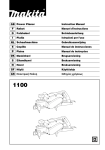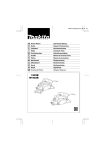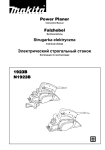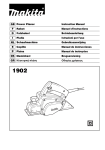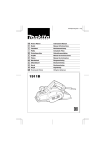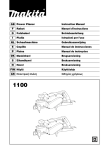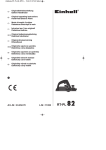Download Makita N1923B Instruction manual
Transcript
1923B (12lang)(cover) (’96. 4. 16) Power Planer Instruction Manual F Rabot Manuel d’Instructions D Falzhobel Betriebsanleitung I Pialla Istruzioni d’Uso Schaafmachine Gebruiksaanwijzing E Cepillo Manual de Instrucciones P Plaina Manual de Instruço˜es DK Maskinhøvl Brugsanvisning S Elhandhyvel Bruksanvisning N Høvel Bruksanvisning SF Höylä Käyttöohje GR ∏ÏÂÎÙÚÈ΋ ¶Ï¿ÓË √‰ËÁ›Â˜ ÃÚ‹Ûˆ˜ GB NL 1923B N1923B 1923B (12lang)(illust)(’96. 4. 16) 1 2 3 4 5 6 7 8 2 1923B (12lang)(illust)(’96. 4. 16) 9 10 11 12 13 14 15 16 3 1923B (12lang)(illust)(’96. 4. 16) 17 18 19 20 21 22 23 24 4 1923B (12lang)(illust)(’96. 4. 16) 25 26 27 5 1923B/N1923B (Eng) (’97. 7. 8) ENGLISH 1 2 3 4 5 6 7 8 9 0 q w e r t y u Bolt Drum Planer blade Drum cover Adjust plate Blade edge Screws Heel Back side of gauge base Inside edge of gauge plate Gauge plate Gauge base Pan head screw Planer blade locating lugs Heel of adjust plate Set plate Inside flank of gauge plate Explanation of general view i o p a s d f g h j k l ; z x Mini planer blade Hex. flange head bolt Groove Knob Switch trigger Lock button/ Lock-off button Start End Blade edge Cutting line Screw Edge fence ‘‘V’’ groove Front base Align the ‘‘V’’ groove with the edge of the workpiece. SPECIFICATIONS Model 1923B/N1923B Planing width ................................................. 82 mm Planing depth ................................................... 1 mm Shiplapping depth .......................................... 23 mm No load speed (RPM) .................................... 16,000 Overall length ............................................... 293 mm Net weight ....................................................... 2.9 kg • Due to the continuing program of research and development, the specifications herein are subject to change without prior notice. • Note: Specifications may differ from country to country. Power supply The machine should be connected only to a power supply of the same voltage as indicated on the nameplate, and can only be operated on single-phase AC supply. They are double-insulated in accordance with European Standard and can, therefore, also be used from sockets without earth wire. Safety hints For your own safety, please refer to enclosed Safety instructions. These symbols mean: Read instruction manual. DOUBLE INSULATION c v b n m , . / ¡ ™ £ ¢ ∞ § ¶ Nozzle assembly Chip cover screw Chip cover Fit pin on nozzle assembly into this hole. Sharpening holder Wing nut Blade (A) Blade (B) Side (C) Side (D) Chip cover Makita vacuum cleaner Limit mark Screwdriver Brush holder cap ADDITIONAL SAFETY RULES 1. Rags, cloth, cord, string and the like should never be left around the work area. 2. Avoid cutting nails. Inspect for and remove all nails from the workpiece before operation. 3. Handle the blades very carefully. 4. Be sure the blade installation bolts are securely tightened before operation. 5. Hold the machine firmly with both hands. 6. Keep hands away from rotating parts. 7. Before using the machine on an actual workpiece, let it run for a while. Watch for vibration or wobbling that could indicate poor installation or a poorly balanced blade. 8. Make sure the blade is not contacting the workpiece before the switch is turned on. 9. Wait until the blade attains full speed before cutting. 10. Keep at least 200 mm away from the machine at all times. 11. Always switch off and wait for the blades to come to a complete stop before any adjusting. 12. Never stick your finger into the chip chute. Chute may jam when cutting damp wood. Clean out chips with a stick. 13. Do not leave the machine running. Operate the machine only when hand-held. 14. When leaving the planer, switch off and set it with the front base up on a wooden block, so that the blades do not contact anything. 15. Always change both blades or covers on the drum, otherwise the resulting imbalance will cause vibration and shorten machine life. 16. Wait for complete run-down before putting the machine aside. 17. Use only Makita blades specified in this manual. SAVE THESE INSTRUCTIONS. 6 1923B/N1923B (Eng) (’97. 7. 15) OPERATING INSTRUCTIONS Removing or installing planer blades Important: • Always be sure that machine is switched off and unplugged before removing or installing the blade. • Use the following planer blades. Part Nos. 793004-6 793007-0 793322-2 *P-04226 *P04282 *P-04298 *820044-1 *820045-1 *820043-1 Blades with * mark are available in European countries only. Consult your dealer or the Makita Service Center when purchasing blades. For machine with standard planer blades (Fig. 1, 3 & 4) To remove the blades on the drum, unscrew the three installation bolts with the socket wrench. The drum cover comes off together with the blades. To install the blades, first clean out all chips or foreign matter adhering to the drum or blades. Use blades of the same dimensions and weight, or drum oscillation/vibration will result, causing poor planing action and, eventually, machine breakdown. Place the blade on the gauge base so that the blade edge is perfectly flush with the inside edge of the gauge plate. Place the adjust plate on the blade, then simply press in the heel of the adjust plate flush with the back side of the gauge base and tighten two screws on the adjust plate. Now slip the heel of the adjust plate into the drum groove, then fit the drum cover on it. Tighten the three installation bolts evenly and alternately with the socket wrench. For machine with mini planer blades (Fig. 1, 5 & 6) 1. Remove the existing blade, if the machine has been in use, carefully clean the drum surfaces and the drum cover. To remove the blades on the drum, unscrew the three installation bolts with the socket wrench. The drum cover comes off together with the blades. 2. To install the blades, loosely attach the adjust plate to the set plate with the pan head screws and set the mini planer blade on the gauge base so that the cutting edge of the blade is perfectly flush with the inside flank of the gauge plate. 3. Set the adjust plate/set plate on the gauge base so that the planer blade locating lugs on the set plate rest in the mini planer blade groove, then press in the heel of the adjust plate flush with the back side of the gauge base and tighten the pan head screws. 4. It is important that the blade sits flush with the inside flank of the gauge plate, the planer blade locating lugs sit in the blade groove and the heel of the adjust plate is flush with the back side of the gauge base. Check this alignment carefully to ensure uniform cutting. 5. Slip the heel of the adjust plate into the groove of the drum. 6. Set the drum cover over the adjust plate/set plate and screw in the three hex flange head bolts so that a gap exists between the drum and the set plate to slide the mini planer blade into position. The blade will be positioned by the planer blade locating lugs on the set plate. 7. The blade’s lengthwise adjustment will need to be manually positioned so that the blade ends are clear and equidistant from the housing on one side and the metal bracket on the other. 8. Tighten the three hex flange head bolts (with the socket wrench provided) and hand rotate the drum to check clearances between the blade ends and the machine body. 9. Check the three hex flange head bolts for final tightness. 10. Repeat procedures 1 – 9 for other blade. For shiplapping (Fig. 7) The blade edge should be made to protrude outside slightly (0.3 mm – 0.6 mm). Otherwise, nicks and generally poor shiplapping results. CAUTION: Tighten the blade installation bolts carefully when attaching the blades to the machine. A loose installation bolt can be dangerous. Always check to see they are tightened securely. 7 1923B/N1923B (Eng) (’97. 7. 15) For the correct planer blade setting Your planing surface will end up rough and uneven, unless the blade is set properly and securely. The blade must be mounted so that the cutting edge is absolutely level, that is, parallel to the surface of the rear base. Below are some examples of proper and improper settings. (A) Front base (Movable shoe) (B) Rear base (Stationary shoe) Correct setting Although this side view cannot show it, the edges of the blades run perfectly parallel to the rear base surface. Nicks in surface Cause: One or both blades fails to have edge parallel to rear base line. Gouging at start Gouging at end Cause: One or both blade edges fails to protrude enough in relation to rear base line. Cause: One or both blade edges protrudes too far in relation to rear base line. Adjusting the depth of cut (Fig. 8) Planing operation (Fig. 11) Depth of cut may be adjusted by simply turning the knob on the front of the machine. First, rest the machine front base flat upon the workpiece surface without the blades making any contact. Switch on and wait until the blades attain full speed. Then move the machine gently forward. Apply pressure on the front of machine at the start of planing, and at the back at the end of planing. Planing will be easier if you incline the workpiece in stationary fashion, so that you can plane somewhat downhill. The speed and depth of cut determine the kind of finish. The power planer keeps cutting at a speed that will not result in jamming by chips. For rough cutting, the depth of cut can be increased, while for a good finish you should reduce the depth of cut and advance the machine more slowly. Switch action CAUTION: Before plugging in the machine, always check to see that the switch trigger actuates properly and returns to the ‘‘OFF’’ position when released. For machine without lock button and lock-off button (Fig. 9) To start the machine, simply pull the trigger. Release the trigger to stop. For machine with lock button (Fig. 10) To start the machine, simply pull the trigger. Release the trigger to stop. For continuous operation, pull the trigger and then push in the lock button. To stop the machine from the locked position, pull the trigger fully, then release it. For machine with lock-off button (Fig. 10) To prevent the trigger from being accidentally pulled, a lock-off button is provided. To start the machine, press the lock-off button and pull the trigger. Release the trigger to stop. 8 1923B/N1923B (Eng) (’97. 7. 15) Shiplapping (Fig. 12, 13, 14 & 15) Connecting a vacuum cleaner To make a stepped cut as shown in Fig. 12, use the edge fence. For European countries and areas (Fig. 24) When you wish to perform clean planing operation, connect a Makita vacuum cleaner to your machine as shown in Fig. 24. Draw a cutting line on the workpiece. Insert the edge fence into the hole in the front of the machine. Align the blade edge with the cutting line. Adjust the edge fence until it comes in contact with the side of the workpiece, then secure it by tightening the screw. You may wish to add to the length of the fence by attaching an extra piece of wood. Convenient holes are provided in the fence for this purpose, and also for attaching an extension guide (optional accessory). NOTE: When planing, move the machine with the edge fence flush with the side of the workpiece. Otherwise uneven planing may result. Max. shiplapping depth is 23 mm. Chamfering (Fig. 16, 17 & 18) To make a cut as shown in Fig. 16, align the ‘‘V’’ groove in the front base with the edge of the workpiece and plane it as shown in the Fig. 18. Nozzle assembly (optional accessory) (Fig. 19 & 20) Use of the special nozzle assembly will minimize chip scatter, making for a cleaner work area. For other countries and areas A nozzle and joint (optional accessories) are necessary to connect a Makita vacuum cleaner to your machine. Consult a Makita catalogue or representative on the nozzle and joint. MAINTENANCE CAUTION: Always be sure that the machine is switched off and unplugged before carrying out any work on the machine. Replacement of carbon brushes (Fig. 25, 26 & 27) Replace carbon brushes when they are worn down to the limit mark. First, remove the chip cover and then replace the carbon brushes. Both identical carbon brushes should be replaced at the same time. To maintain product safety and reliability, repairs, maintenance or adjustment should be carried out by Makita Authorized Service Center. The nozzle assembly may be attached after the chip cover on the machine body is removed. When slipping on the assembly, fit the pin on it into the rear cover hole. Use the chip cover screws to fasten it in place. Sharpening the planer blades (Fig. 21, 22 & 23) For standard blades only Always keep your blades sharp for the best performance possible. Use the sharpening holder to remove nicks and produce a fine edge. First, loosen the two wing nuts on the holder and insert the blades (A) and (B), so that they contact the sides (C) and (D). Then tighten the wing nuts. Immerse the dressing stone in water for 2 or 3 minutes before sharpening. Hold the holder so that the blades both contact the dressing stone for simultaneous sharpening at the same angle. 9 1923B (Nl) (’100. 6. 26) NEDERLANDS 1 2 3 4 5 6 7 8 9 0 q w e r t y u Verklaring van algemene gegevens Bout Schaafblok Schaafmes Afdekplaat van schaafblok Afstelplaat Mesrand Schroeven Hiel Zijkant van mal Binnenrand kaliberplaat Kaliberplaat Kalibervoet Kruiskopschroef Vastzetnokjes schaafmes Hiel van afstelplaat Aanzetplaat Binnenkant van kaliberplaat i o p a s d f g h j k l ; z x Mini schaafmes Zeskante bout Groef Knop Trekkerschakelaar Vergrendelknop/ Ontgrendelknop Start Einde Mesrand Snijlijn Schroef Breedtegeleider ‘‘V’’ groef Voorste voetstuk Zorg dat de ‘‘V’’ groef op de rand van het werkstuk blijft. TECHNISCHE GEGEVENS Model 1923B/N1923B Schaafbreedte ................................................ 82 mm Max. schaafdiepte ............................................ 1 mm Sponningdiepte .............................................. 23 mm Toerental onbelast/min. .................................. 16 000 Totale lengte ................................................ 293 mm Netto gewicht .................................................. 2,9 kg • In verband met ononderbroken research en ontwikkeling behouden wij ons het recht voor bovenstaande technische gegevens te wijzigen zonder voorafgaande kennisgeving. • Opmerking: De technische gegevens kunnen van land tot land verschillen. Stroomvoorziening De machine mag alleen worden aangesloten op een stroombron van hetzelfde voltage als aangegeven op de naamplaat, en kan alleen op enkel-fase wisselstroom worden gebruikt. De machine is dubbel-geı¨soleerd volgens de Europese standaard en kan derhalve ook op een niet-geaard stopcontact worden aangesloten. Veiligheidswenken Voor uw veiligheid dient u de bijgevoegde Veiligheidsvoorschriften nauwkeurig op te volgen. Deze symbolen betekenen: Lees de gebruiksaanwijzing. DUBBELE ISOLATIE AANVULLENDE VEILIGHEIDSVOORSCHRIFTEN 1. Lompen, doeken, touwen en soortgelijke prullen dienen nooit in het werkgebied achtergelaten te worden. 2. Zorg dat het gereedschap nooit in kontakt komt met spijkers. Verwijder alvorens te schaven eventuele spijkers van het werkstuk. 22 c v b n m , . / ¡ ™ £ ¢ ∞ § ¶ Spaanafvoer Schroefvoor Spaanafvoer Spaanafvoer Steek de pen op de Spaanafvoer Aanscherphouder Vleugelmoer Mes (A) Mes (B) Zijkant (C) Zijkant (D) Spaanafvoer Makita stofzuiger Limiet markering Schroevedraaier Kap van de koolborstelhouder 3. Wees zeer voorzichtig met de messen. 4. Kontroleer alvorens te schaven of de bevestigingsbouten van de messen stevig vastgedraaid zijn. 5. Houd het gereedschap met beide handen stevig vast. 6. Houd uw handen uit de buurt van de bewegende delen. 7. Alvorens het gereedschap op een werkstuk te gebruiken, laat u het een tijdje draaien. Onderzoek het op vibraties of schommelende bewegingen die op een onjuiste installatie of onjuist gebalanceerde messen kunnen wijzen. 8. Zorg dat de messen niet in aanraking zijn met het werkstuk als u het gereedschap in wilt schakelen. 9. Wacht alvorens te schaven tot de messen op volle snelheid draaien. 10. Zorg dat u het gereedschap ten alle tijde op een afstand houdt van minstens 200 mm. 11. Alvorens iets bij te stellen dient u altijd het gereedschap uit te schakelen en te wachten totdat de messen volledig tot stilstand zijn gekomen. 12. Steek uw vinger nooit in de spaanafvoer. De spanen kunnen erin klem raken als u nat hout schaaft. Verwijder in dit geval de spanen met een stukje hout. 13. Schakel altijd uit als u het gereedschap niet gebruikt. Schakel het gereedschap alleen in als u het in handen houdt. 14. Wanneer u het gereedschap achterlaat, schakel het uit en zet het op een plankje met het voorstuk naar boven gericht zodat de messen niets aanraken. 1923B (Nl) (’100. 6. 26) 15. Vervang altijd gelijktijdig beide messen en klemplaten, aangezien anders het resulterende verlies van evenwicht trillingen kunnen veroorzaken, waardoor de gebruiksduur van het gereedschap verkort kan worden. 16. Wacht totdat de messen volledig tot stilstand zijn gekomen, alvorens de machine opzij te zetten. 17. Gebruik alleen Makita messen die in deze gebruiksaanwijzing zijn gespecificeerd. BEWAAR DEZE VOORSCHRIFTEN. BEDIENINGSVOORSCHRIFTEN Verwijderen of installeren van de schaafmessen Belangrijk: • Controleer altijd of de machine is uitgeschakeld en het netsnoer uit het stopcontact is verwijderd, alvorens de messen te verwijderen of te installeren. • Gebruik de volgende schaafmessen. Onderdeelnr. 793004-6 793007-0 793322-2 *P-04226 *P-04282 *P-04298 *820044-1 *820045-1 *820043-1 De met * gemarkeerde messen zijn alleen in Europese landen verkrijgbaar. Raadpleeg uw dealer of het Makita Service-centrum wanneer u messen wilt kopen. Voor machines met standaard-schaafmessen (Fig. 1, 3 en 4) Om de messen van het schaafblok te verwijderen, draait u met de soksleutel de drie bevestigingsbouten los. De afdekplaat kunt u dan tegelijk met de messen verwijderen. Alvorens de nieuwe messen te installeren, verwijder eerst alle schaafkrullen of verontreinigingen van het schaafblok of de messen. Gebruik messen van dezelfde afmetingen en hetzelfde gewicht, omdat het schaafblok anders zal slingeren of trillen, zodat de machine niet gelijk zal schaven en eventueel defect kan raken. Plaats het mes zodanig op de kalibervoet, dat de scherpe kant van het mes volkomen vlak ligt met de binnenrand van de kaliberplaat. Plaats de afstelplaat op het mes, druk dan de hiel van de afstelplaat naar beneden totdat deze vlak ligt met de kalibervoet, en draai dan de twee schroeven op de afstelplaat vast. Schuif nu de hiel van de afstelplaat in de groef van het schaafblok, en plaats dan de afdekplaat van het schaafblok erop. Draai de drie bevestigingsbouten gelijkmatig en afwisselend vast met behulp van de soksleutel. Voor machines met mini-schaafmessen (Fig. 1, 5 en 6) 1. Indien de machine pas is gebruikt, verwijdert u eerst het gebruikte schaafmes. Maak vervolgens de oppervlakken en de afdekplaat van het schaafblok grondig schoon. Om de messen van het schaafblok te verwijderen, draait u met de soksleutel de drie bevestigingsbouten los. De afdekplaat kunt u dan tegelijk met de messen verwijderen. 2. Om de nieuwe messen te installeren, bevestig de afstelplaat losjes op de klemplaat met behulp van de kruiskopschroeven en plaats dan het minischaafmes zodanig op de kalibervoet, dat de scherpe kant van het mes volkomen vlak ligt met de binnenrand van de kaliberplaat. 3. Plaats de afstelplaat/aanzetplaat op de mal zodat de vastzetnokjes op de aanzetplaat in de groef van het mini schaafmes rusten. Druk vervolgens de zool van afstelplaat totdat deze gelijk komt met de zijkant van de mal en draai de schroeven vast. 4. Het is belangrijk dat het schaafmes gelijk en vlak tegen de binnenkant van de malplaat aanligt, dat de vastzetnokjes in de groef van het schaafmes rusten en dat de zool van de afstelplaat volkommen gelijk is met de zijkant van de mal. Kontroleer of dit zo is, aangezien het gereedschap anders niet gelijk kan schaven. 5. Schuif de zool van de afstelplaat in de groef van het schaafblok. 6. Plaats de afdekplaat van het schaafblok op de afstelplaat/aanzetplaat en draai de drie zeskantbouten vast, echter zo dat er een spleet blijft bestaan tussen het schaafblok en de aanzetplaat om het mini schaafmes op z’n plaats te schuiven. Door de vastzetnokjes zal het mes op de aanzetplaat vastgehouden worden. 7. De lengte van het mes dient met de hand zo te worden bijgesteld dat de uiteinden van het mes op gelijke afstand van de behuizing aan de ene kant en de metalen beugel aan de andere kant uitsteken. 8. Draai de drie zeskantbouten met de bijgeleverde soksleutel vast. Kontroleer of het mes even ver van het schaafblok uitsteken. 9. Kontroleer of de drie zeskante bouten goed zijn aangetrokken. 10. Herhaal de procedure, vanaf stap 1 tot en met 9 voor het monteren van een ander schaafblad. Voor rabatten (Fig. 7) Zorg ervoor dat de scherpe rand van het mes een beetje (0,3 mm – 0,6 mm) uitsteekt. Indien dit wordt verzuimd, zal het schaven resulteren in kerven en slecht rabatten. (Sponning schaven) LET OP: Trek de bevestigingsbouten zorgvuldig aan wanneer u de messen aan de machine bevestigt. Een losse bevestigingsbout kan gevaar opleveren. Controleer altijd of de bouten goed zijn vastgedraaid. 23 1923B (Nl) (’100. 6. 23) Voor de juiste mesinstelling Uw schaafvlak zal ruw en ongelijk worden, indien het mes niet correct is ingesteld. Het mes moet dusdanig gemonteerd worden dat de zijkant absoluut gelijk ligt ofwel parallel met het vlak van de achterzool. Onderstaand enkele voorbeelden van juiste en onjuiste instellingen. (A) Voor zool (beweegbaar) (B) Achterzool (vast) Correcte instelling Ofschoon dit zijaanzicht het niet toont, draaien de snijkanten van het mes perfect parallel met de achterzool. Happen in het oppervlak Oorzaak: Eén van beide messen staat niet parallel ingesteld met achterzool. Gutsen bij het begin Gutsen het eind Oorzaak: Eén van beide messen steekt niet voldoende uit in relatie tot achterzool. Oorzaak: Eén van beide messen steekt te ver uit in relatie tot achterzool. Instellen van schaafdiepte (Fig. 8) Schaven (Fig. 11) De schaafdiepte is heel eenvoudig in te stellen door de knop voor op het gereedschap te verdraaien. Leg eerst het voorste zoolvlak plat op het oppervlak van het werkstuk, zonder dat de messen nog iets aanraken. Schakel het gereedschap in en wacht totdat de messen op volle snelheid draaien. Hierna beweegt u het gereedschap langzaam vooruit. Oefen druk uit op het voorste gedeelte van het gereedschap als u begint te schaven en op het achterste gedeelte als het einde nadert. Het schaven gaat gemakkelijker als u het werkstuk een beetje schuin houdt, zodat u schaaft met het gereedschap iets naar beneden gericht. Werking van de trekkerschakelaar LET OP: Alvorens de machine op netstroom aan te sluiten, dient u altijd te controleren of de trekkerschakelaar behoorlijk werkt en bij het loslaten naar de ‘‘OFF’’ positie terugkeert. Voor machines zonder vergrendelknop en ontgrendelknop (Fig. 9) Om de machine in te schakelen, drukt u gewoon de trekkerschakelaar in. Laat de schakelaar los om de machine uit te schakelen. Voor machines met een vergrendelknop (Fig. 10) Om de machine in te schakelen, drukt u gewoon de trekkerschakelaar in. Laat de schakelaar los om de machine uit te schakelen. Voor continu gebruik, eerst de trekkerschakelaar en dan de vergrendelknop indrukken. Om de machine vanuit de vergrendelde stand te stoppen, de trekkerschakelaar helemaal indrukken en deze dan loslaten. Voor machines met een ontgrendelknop (Fig. 10) Een ontgrendelknop is voorzien om te voorkomen dat de trekkerschakelaar per toeval wordt ingedrukt. Om de machine te starten, druk de ontgrendelknop in en druk dan de trekkerschakelaar in. Om de machine te stoppen, de trekkerschakelaar loslaten. 24 De snelheid waarmee u schaaft en de schaaftdiepte bepalen het resultaat. De snelheid van het gereedschap zelf is zodanig dat de spanen nooit klemraken. Voor ruw schaven kunt u de schaafdiepte vermeerderen, terwijl voor een goede afwerking de schaafdiepte verminderd moet worden en het gereedschap langzamer vooruitbewogen dient te worden. 1923B (Nl) (’100. 6. 26) Rabatten (Fig. 12, 13, 14 en 15) Aansluiten van een stofzuiger Gebruik de zijkantgeleider voor zijdelings schaven zoals afgebeeld in Fig. 12. Voor Europese landen en gebieden (Fig. 24) Voor schoon schaven sluit u een Makita-stofzuiger aan op uw machine (zie Fig. 24). Breng op het werkstuk de snijlijn aan. Steek de zijkantgeleider in het gaatje aan de voorkant van het gereedschap. Zet het mes op de snijlijn. Stel de zijkantgeleider zodanig in dat deze volledig kontakt maakt met de zijkant van het werkstuk. Zet de geleider vervolgens vast door middel van de schroef. Soms is het wenselijk voor betere geleiding van het gereedschap de geleider te verbreden. Dit kunt u doen door een lat te bevestigen. De geleider is voor dit doel voorzien van gaten, die ook kunnen dienen voor het bevestigen van een verlengstuk (los verkrijgbaar toebehoren). OPMERKING: U dient tijdens het schaven de zijkantgeleider steeds tegen de zijkant van het werkstuk te houden, aangezien anders de snede ongelijkmatig wordt. De maximale sponningsdiepte is 23 mm. Afschuinen (Fig. 16, 17 en 18) Voor het maken van sneden zoals afgebeeld in Fig. 16, zorg ervoor dat de ‘‘V’’ groef in het voorste voetstuk van de machine op de rand van het werkstuk rust, en schaaf dan zoals afgebeeld in Fig. 18. Spaanafvoer (los verkrijgbaar toebehoren) (Fig. 19 en 20) Door gebruikmaking van de speciale spaanafvoer kan het rondvliegen van schaafkrullen tot een minimum worden beperkt. Hierdoor zal de werkruimte er schoner gaan uitzien. Voor andere landen en gebieden Om een Makita-stofzuiger aan uw machine te bevestigen, hebt u een verbindingsstuk en scharnierstuk (los verkrijgbare accessoires) nodig. Voor het verbindingsstuk en scharnierstuk dient u een catalogus of vertegenwoordiger van Makita te raadplegen. ONDERHOUD LET OP: Zorg er altijd voor dat de machine is uitgeschakeld en de stekker uit het stopcontact is verwijderd alvorens werken aan de machine uit te voeren. Vervangen van koolborstels (Fig. 25, 26 en 27) Vervang de koolborstels wanneer deze tot aan de limietmarkering zijn versleten. Verwijder eerst de schaafkrulkap en vervang dan de koolborstels. Vervang altijd beide koolsborstels gelijktijdig door gelijksoortige koolborstels. Opdat het gereedschap veilig en betrouwbaar blijft, dienen alle reparaties, onderhoud of afstellingen te worden uitgevoerd bij een erkend Makita service centrum. De spaanafvoer kan worden bevestigd nadat de standaard spaanafvoer van de machine is verwijderd. Bij het bevestigen van de spaanafvoer dient u de daarop aanwezige pen in het achterste gat van het machinehuis te steken. Gebruik dezelfde schroeven om de spaanafvoer te bevestigen. Aanscherpen van de schaafmessen (Fig. 21, 22 en 23) Alleen voor standaard-schaafmessen Houd uw schaafmessen altijd scherp om de best mogelijke resultaten te krijgen. Gebruik de aanscherphouder. Om bramen te verwijderen of de beitels aan te scherpen. Draai eerst de twee vleugelmoeren op de houder los en steek messen (A) en (B) erin zodat deze met zijkanten (C) en (D) in aanraking komen. Draai dan de twee vleugelmoeren vast. Dompel de wetsteen voor 2 of 3 minuten in water alvorens aan te scherpen. Houd de aanscherphouder zodanig, dat beide messen met de wetsteen in aanraking komen voor gelijktijdig aanscherpen onder dezelfde hoek. 25
This document in other languages
- Nederlands: Makita N1923B













